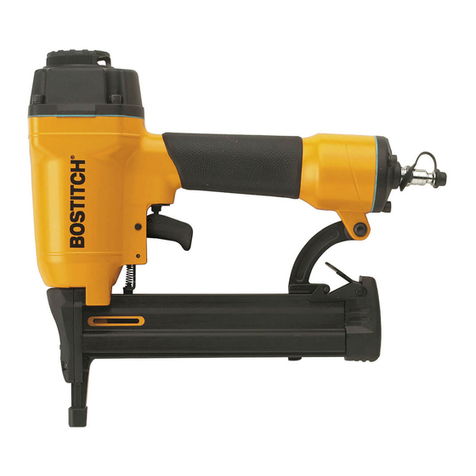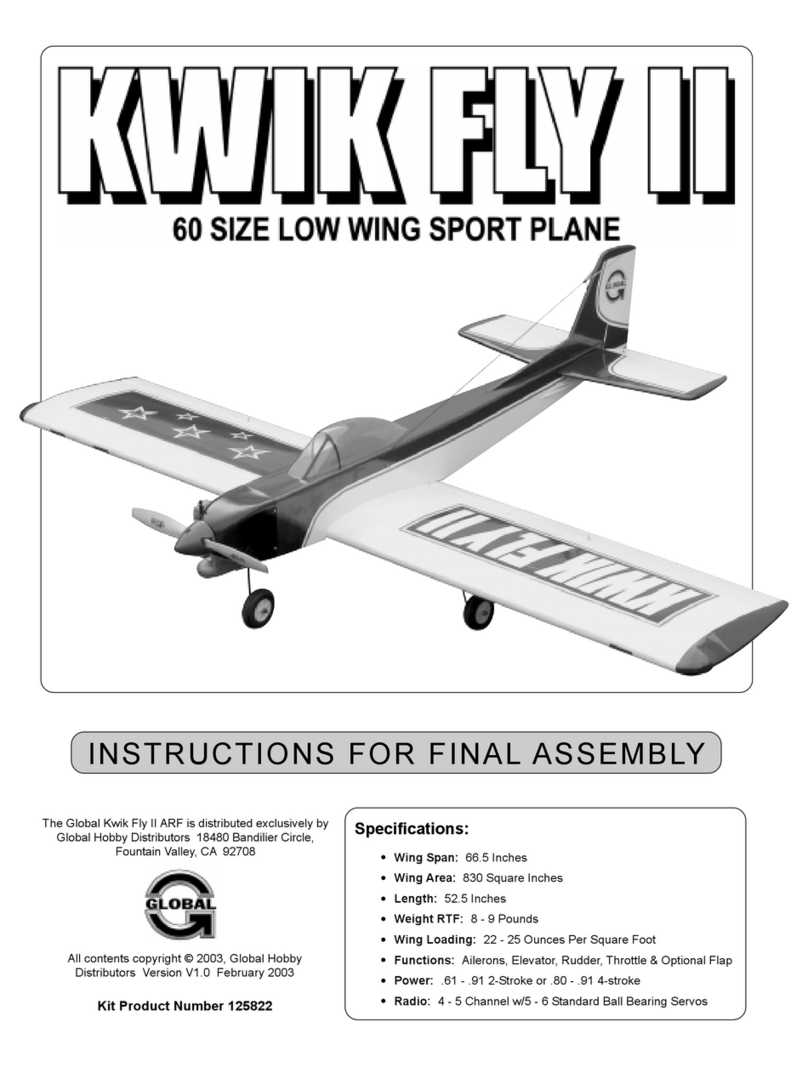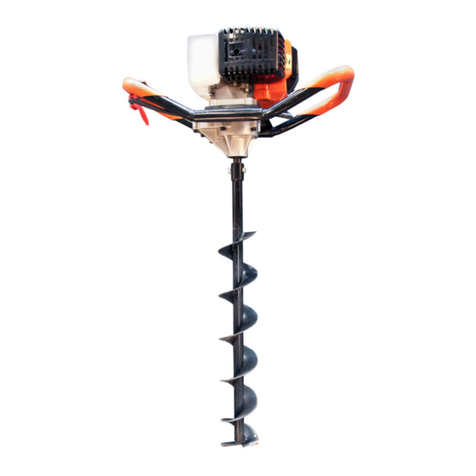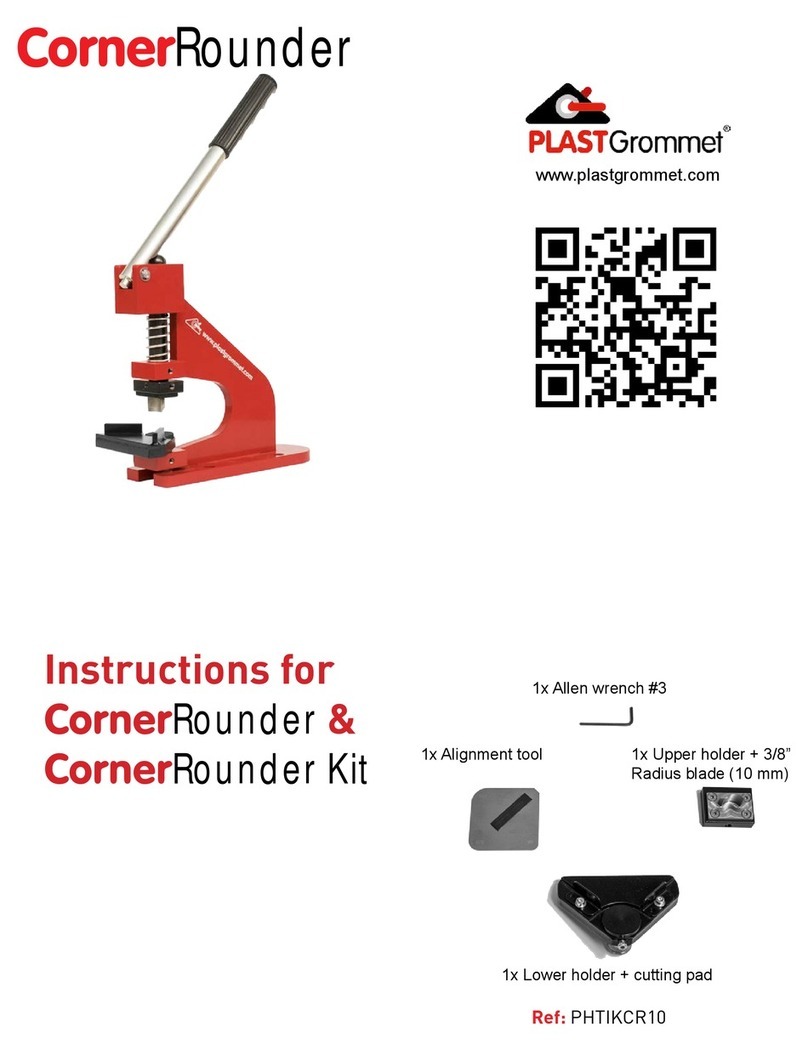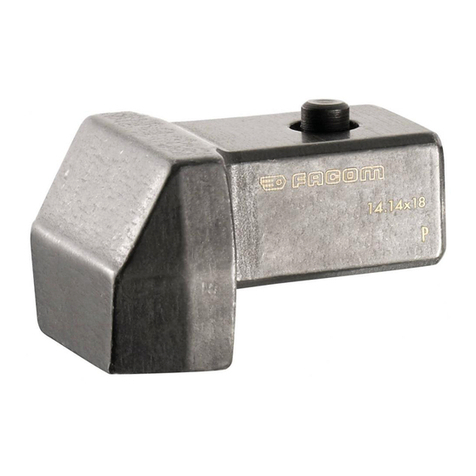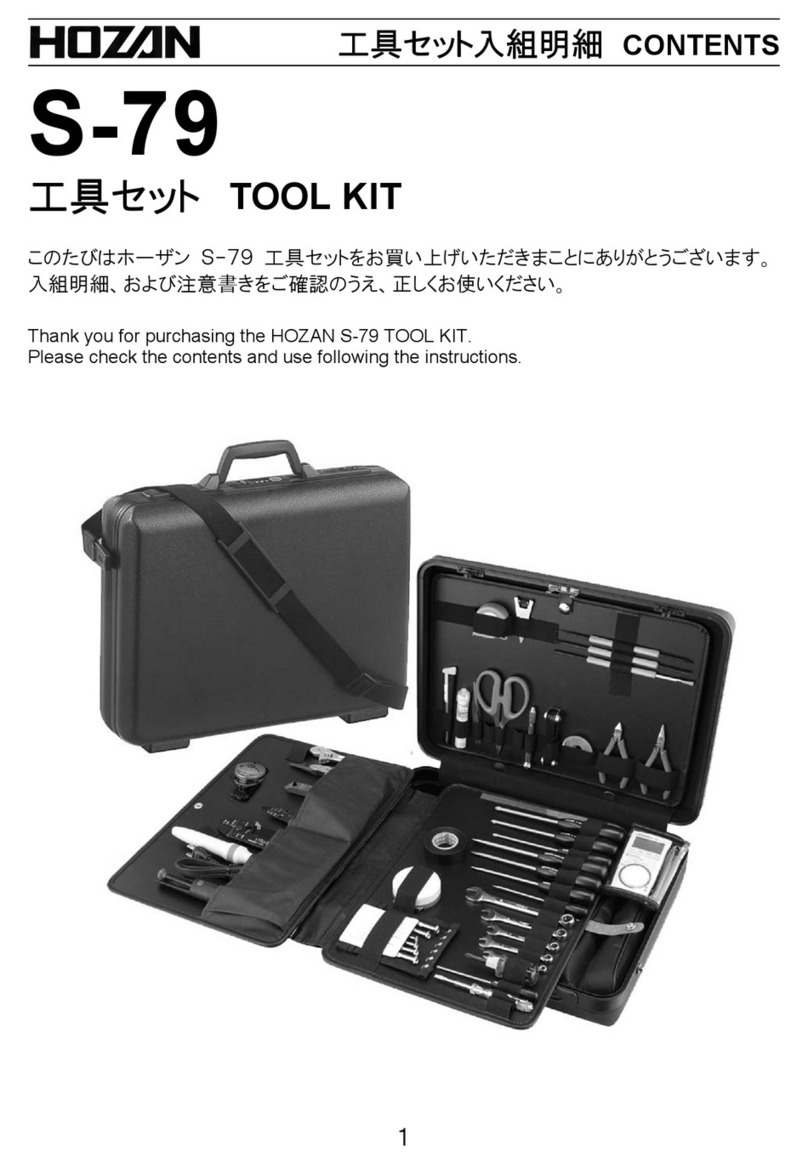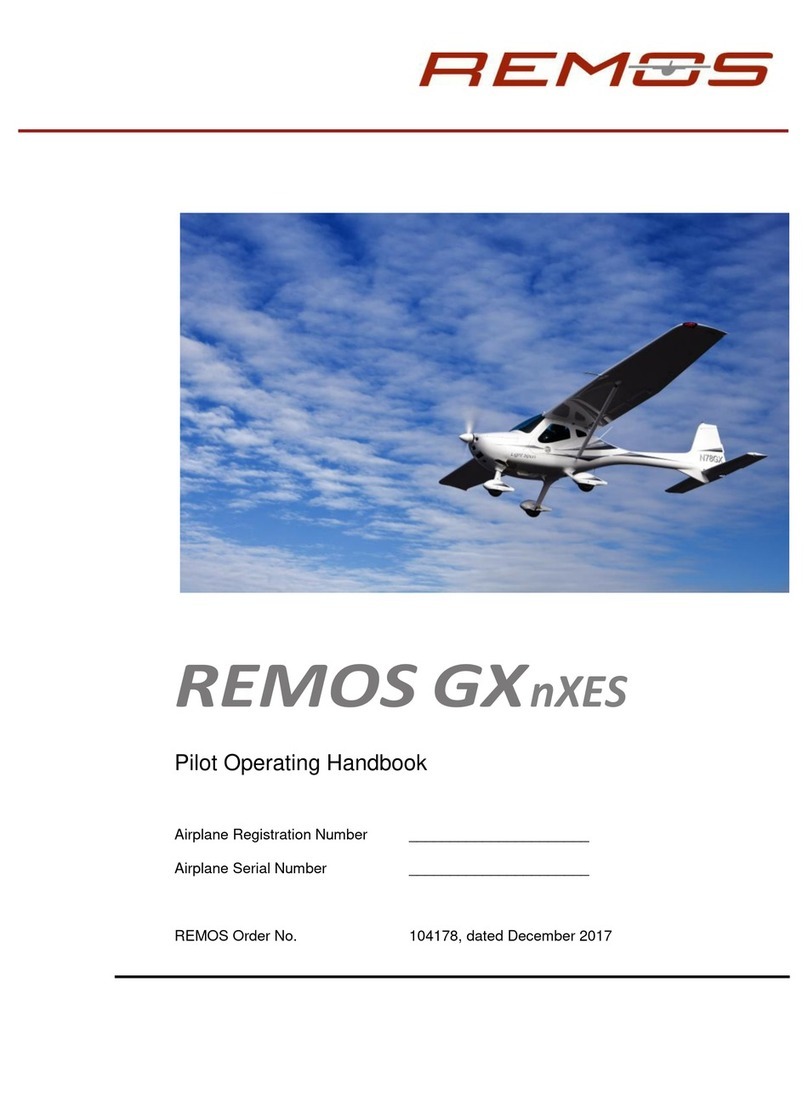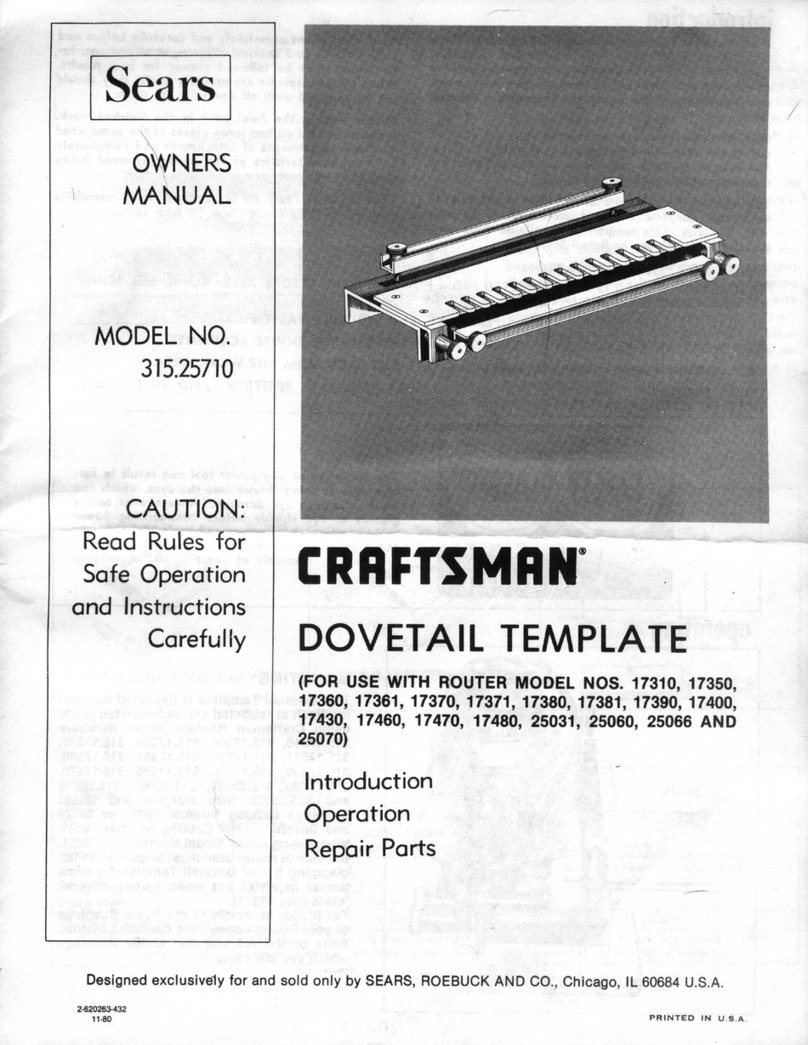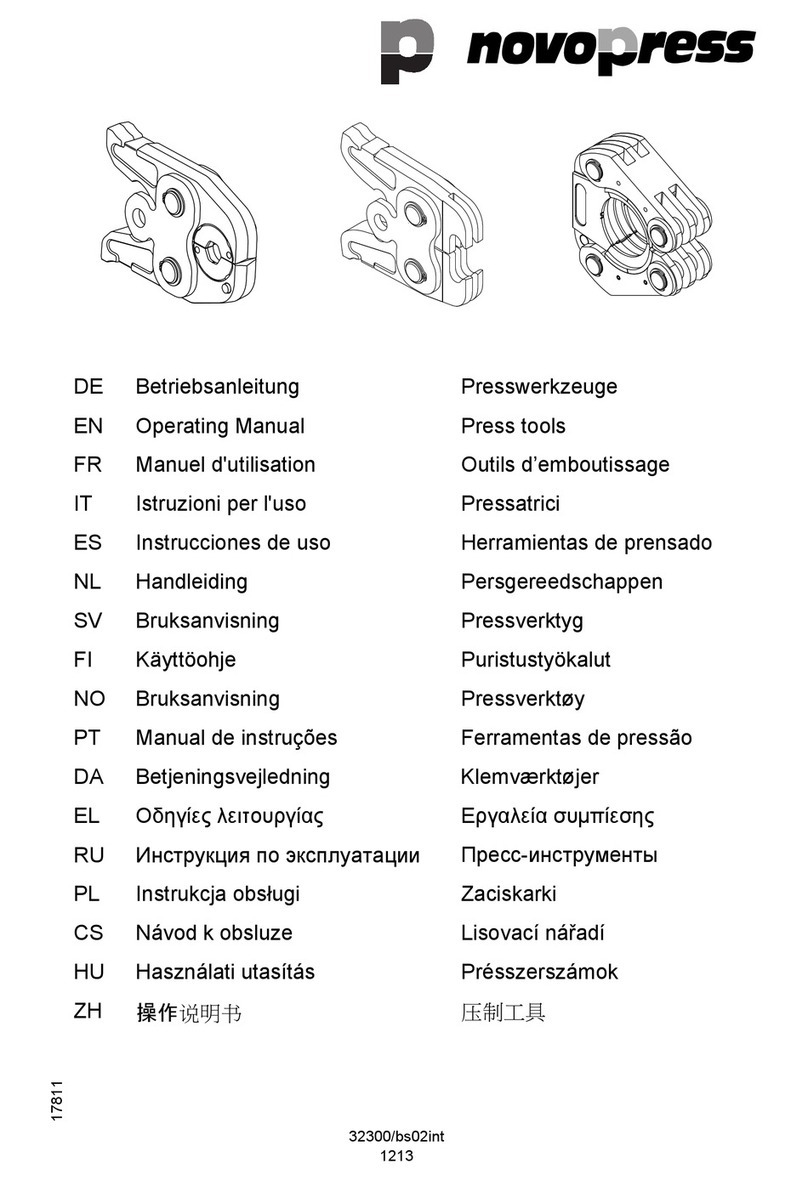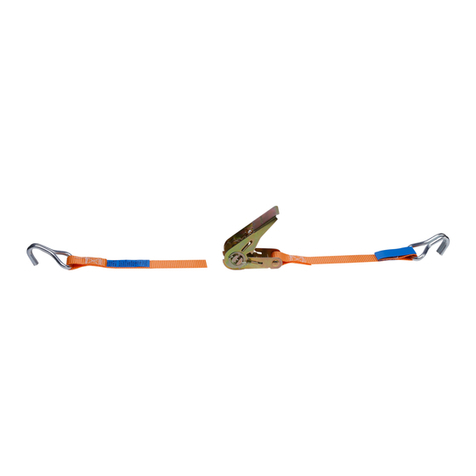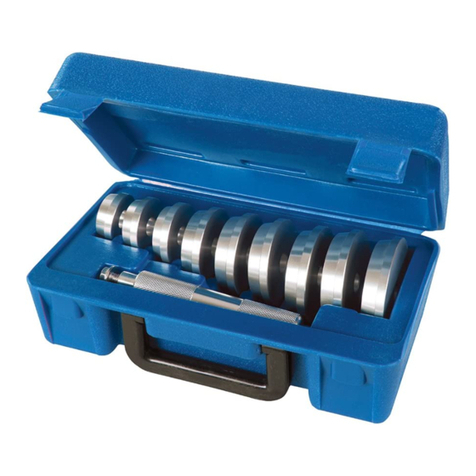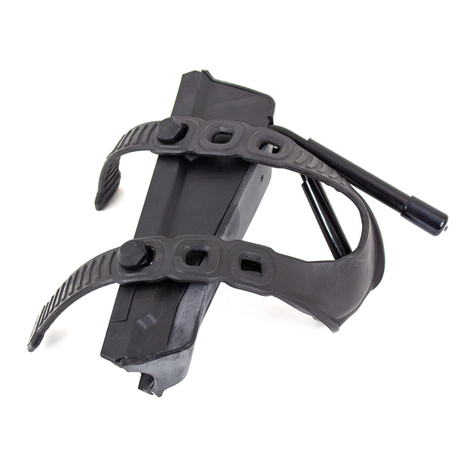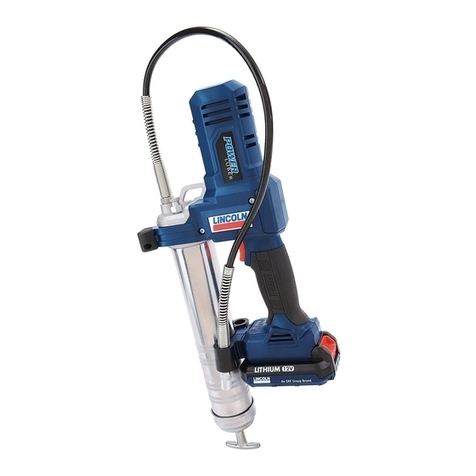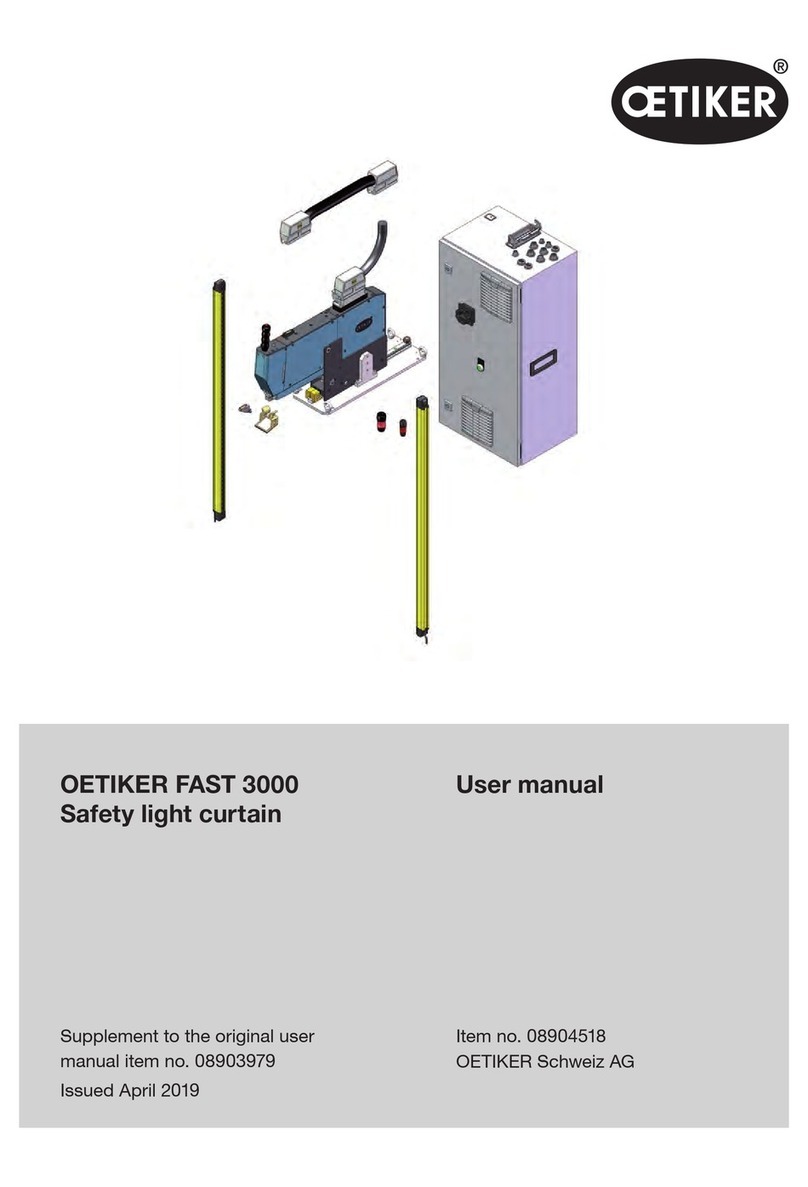Tractel tirfor TU Series Manual

equipment in
accordance with
CE directives
operating and maintenance instructions
models
TU : TU-8
TU-16
TU-32
T-500D : T-508D
T-516D
T-532D
lifting and pulling machines
tirfor
1
®®
0086086.03 - 01/95
Anglia Handling Services Ltd

2
CONTENTS Page
General warning 3
Technical data 3
1. Description of equipment 4
2. Rigging arrangements 4
3. Installing the wire rope 5
4. Releasing and closing the jaws 5
5. Anchoring 7
6. Operation 8
7. Releasing the wire rope and storage 8
8. Safety devices 9
9. Replacing the shear pins 9
10. Wire rope 10
11. Maintenance instructions 10
12. Warnings against hazardous operations 11
13. Troubleshooting 11
14. Health and safety at work 11
Always concerned to improve the quality of its
products, the TRACTEL Group reserves the right
to modify the specifications of the equipment
described in this manual. The companies of the
TRACTEL Group and their agents or distributors
will supply on request descriptive documentation
onthefullrange ofTRACTEL products: liftingand
pulling machines, permanent and temporary
accessequipment,safetydevices,electronicload
indicators, accessories such as pulley blocks,
hooks, slings, ground anchors, etc...
Fig. 1
TU-32
8
1
7
6
32451
8
T-508D
T-516D
T-532D
71
6
432
8
1. Hook / anchor pin
2. Forward operating lever
3. Reverse operating lever
4. Rope release lever
5. Rope release safety catch
6. Rope guide
7. Wire rope
8. Telescopic operating handle
7
4532
8
TU-8*
TU-16
5
ORIGINAL MANUAL
*without carrying handle
Wire rope on reeler
The TRACTEL network is able to supply an
after-sales and regular maintenance service.
Shouldyouhaveanyqueriesorrequiretechnical
assistance, please do not hesitate to contact
your TRACTEL dealer.
Anglia Handling Services Ltd

3
TECHNICAL DATA
MODEL TU-8 T-508D TU-16 T-516D TU-32 T-532D
Maximum working load t 0.8 1.6 3.2
Weight :
machine kg 8.4 6.6 18.0 13.5 27.0 24.0
telescopic operating handle kg 1.0 1.0 2.4 2.3 2.4 2.3
s
tandard 20 m of wire rope, complete
kg 6.1 6.1 13.1 13.1 26.6 26.6
Total weight of standard equipment kg 15.5 13.7 33.5 28.9 56.0 52.9
Machine dimensions :
length mm 527 420 660 530 676 620
length with optional hook mm – 550 – 650 860 840
height mm 265 250 330 315 330 355
width mm 108 99 140 127 156 130
telescopic handle : closed/extended
cm 51/77 40/69 68/119 65/115 68/119 65/115
TIRFOR wire rope
diameter mm 8.3 11.5 16.3
guaranteed breaking strain* kg 4000 8000 16000
weight per meter kg 0.250 0.500 1.00
Rope travel (forward/reverse)** mm 70/76 46/63 56/70 42/57 30/48 18/36
* Including end fittings of the wire rope.
** One complete cycle of the operating lever at maximum working load.
!
GENERAL WARNING
!
1- Before using the TIRFOR machine it is essential for the safe and correct operation of the
equipmentthatthismanualbereadandfullyunderstoodandthatalltheinstructionsbefollowed.
This manual should be made available to every operator. Extra copies of this manual will be
supplied on request.
2- The TIRFOR machine allows the operator to carry out work with complete safety. Ensure that this
machine is only handed over for use or rigging to an operator who is trained to operate it in a
responsible manner.
3- Neveruseamachinewhichisnotingoodworkingcondition.Replaceanywornordamagedwire
rope (See Section 10). Continuous monitoring of the condition of the machine, its wire rope and
anchor sling is an important safety consideration.
4- The manufacturer declines any responsibility for the consequences of dismantling or altering the
machine by any unauthorised person. Specially excluded is the replacement of original parts by
parts of another manufacturer.
5- The models as described in this manual must not be used for lifting people.
6- Moreover, these models are designed for manual operation and must not be motorised.
The TRACTEL Group has designed special motorised models (TU-16H and TU-32H).
7- Never attempt to overload the machine.
8- Standard TIRFOR machines are not designed for use in explosive atmospheres.
9- IMPORTANT:Iftheequipmentdescribedinthismanualissuppliedtoanemployedperson,check
thatyoumeetyourobligationswithrespecttosafetyatworkregulations(seepage11-chapter 14)
LIFTING PEOPLE AND SPECIAL APPLICATIONS
For further information on equipment for lifting people, and on any special application, please refer to
Tractel S.A.
Anglia Handling Services Ltd

4
1. DESCRIPTION OF EQUIPMENT
The TIRFOR machine is a hand-operated lifting
and pulling machine. It is versatile, portable and
multi-purpose, not only for pulling and lifting but
also for lowering, tensioning and guying.
The originality of the TIRFOR machine is the
principle of operation directly on the wire rope
which passes through the mechanism rather than
beingreeledontoadrumofahoistorconventional
winch.Thepull isappliedbymeansoftwo pairsof
self-energised jaws which exert a grip on the wire
ropeinproportiontotheloadbeingliftedorpulled.
A telescopic operating lever fitted to either the
forward or the reverse lever transmits the effort to
the jaw mechanism to give forward or reverse
movement of the wire rope.
The machine is fitted with a hook or anchor pin,
dependingonthemodel,sothatitcanbesecured
quickly to any suitable anchor point.
TIRFOR machines, intended for lifting and pulling
materials, are available in two ranges each with
three models of different capacities :
–T-500D range for light duty applications (with
safety release catch)
–TUrangeforheavydutyapplications(withsafety
release catch).
Each machine is supplied with a telescopic
operatinghandle,andusuallywitha20mstandard
length of special TIRFOR wire rope fitted with a
safetyhookandwoundontoametalreeler.Longer
or shorter lengths of wire rope are available on
request.
This manual together with a guarantee card are
supplied with each machine, as well as the CE
declaration of conformity.
IMPORTANT:TIRFORwireropehasbeenspecially
designed to meet the particular requirements of
the TIRFOR machine. The manufacturer does not
guarantee the safe operation of machines used
with wire rope other than TIRFOR wire rope.
2. RIGGING ARRANGEMENTS
VariouswaysofriggingareshowninFigs.2.1,2.2,
2.3 and 2.4. Figs. 4 and 5 show particular
arrangements (one forbidden and the other
recommended).
Themachinemaybeanchoredtoafixedpointwith
the wire rope travelling towards the machine
(Figs. 2.1, 2.2, 2.3), or travel along the wire rope,
with the load, the wire rope itself anchored to a
fixed point (Fig. 2.4).
In example 2.2, the maximum working load of the
pulley and the anchor point should be equal to or
greater than twice the load.
Fig. 2.1 Fig. 2.2
Fig. 2.3 Fig. 2.4
Fig. 3
N.B.Whatever therigging arrangement,and ifthe
machine is anchored directly to a fixed point,
ensure that there are no obstructions around the
machine which could prevent the wire rope, the
machine and anchor from operating in a straight
line. It is therefore recommended to use a sling of
anappropriatecapacitybetweentheanchorpoint
and the machine (Fig. 3).
!
WARNING
!
: Any rigging arrangement
whichrequiresthecalculationoftheforcesapplied
shouldbecheckedbyacompetentengineer,with
special attention to the appropriate strength of
fixed point used.
For work such as guiding the trunk in tree felling,
the operator should ensure that he is outside the
danger area by passing the wire rope around one
or more return pulleys.
Anglia Handling Services Ltd

5
3. INSTALLATING THE WIRE ROPE
N.B. When handling the wire rope it is
recommendedto protectthehandsby usingwork
gloves.
If the wire rope is to be anchored to a high anchor
point, the wire rope should be anchored before
fitting the wire rope in the machine.
1. Uncoil the wire rope in a straight line to prevent
loops or kinks.
2. Releasetheinternalmechanism (Seesection4:
«Releasing and engaging the jaws»).
3. Insert the wire rope through the rope guide at
the end opposite to the anchor point (hook or
anchor pin).
4. Push the wire rope through the machine, and if
necessary, helping it by operating the forward
operating lever.
5. Whenthewireropeappearsthroughtheanchor
point, pull the slack wire rope through the
machine, to the point required.
6. Engage the jaws by operating the rope release
mechanism (See section 4 : «Releasing and
engaging the jaws»).
7. Anchor the TIRFOR machine or the wire rope to
the appropriate fixed point (See section 5 :
«Anchoring») taking care to ensure that the
anchor point ( hook or pin, depending on the
model) is correctly fixed.
8. Extendthetelescopicoperatinghandleuntilthe
spring locks into position. If necessary twist the
two sections of the handle, one inside other, to
align the spring (Fig. 1).
9. Replacethetelescopic operatinghandleon the
chosenoperatinglever(forwardorreverse)and
twist the handle to ensure that it is locked in
position (about a half turn).
After this procedure, the machine is ready for
operation,providingtheloadiscorrectlyanchored
to the machine or the wire rope (See section 5 :
«Anchoring» and section 2 «Rigging
arrangements»).
4.RELEASING AND CLOSING THE JAWS
Eachmachineisfittedwithalever(Fig.1Item4)for
releasingthejawmechanismwhichshouldonlybe
operated when the machine is not under load.
There are two positions for the rope release lever
(See Fig. 7, 8 and 9) : released or engaged.
N.B.Whennotinoperation,itisrecommendedthat
the rope release lever should be in the engaged
position. The machine must therefore be released
before attempting to feed in the wire rope.
Fig. 4 Fig. 5
Fig. 6.1 - Pulling
2 2 2 2 2 2
2
2
2 2
2
13
4
1
11111
111 11111
11
11
1
1
1
1
1
1
3
1
1
1
1
1
1
1
2
1
22
2
2
4
1
1
1
1
1
2
2
1
3
4
4
Fig. 6.2 - Lifting
INCORRECT CORRECT
The capacity of the machine may be increased
considerablyforthesameeffortbytheoperatorby
using multiple sheave blocks. (See the examples
set out in Figs. 6.1 and 6.2). The increase in the
capacity shown is reduced depending on the
efficiency of the pulleys.
The diameter of the pulleys used should be equal
to at least 18 times the diameter of the wire rope.
(Refer to the applicable regulations).
For any rigging arrangement other than those
described in this manual, please consult
TRACTEL S.A. or a competent specialist
engineer before operating the machine .
Anglia Handling Services Ltd

6
4.1. TU-8 or TU-16 (Fig.7)
Releasing :
1. Completely press the rope release safety catch
(5) and lift the rope release lever (4).
2. Release the safety catch and continue to lift the
rope release lever until it locks into position. The
internal mechanism is in the released position.
Engaging :
1. Lift the rope release lever slightly.
2. Pressandmaintainpressureontheroperelease
safetycatch, allowingthereleaseleverto slowly
travel back to its original position. Release the
safety catch. The release lever locks in position
under the effect of its spring.
4.2. TU-32 (Fig.8)
Place the anchor point against a support.
Releasing :
1. Completely press rope release safety catch (5)
and push the rope release lever (4) towards the
anchor point.
2. Release the safety catch and continue to push
the rope release lever until it locks into position.
Theinternalmechanismisinthereleasedposition.
Engaging :
1. Push the rope release lever towards the anchor
point.
2. Pressandmaintainpressureontheroperelease
safetycatch, allowingthereleaseleverto slowly
travel back to its original position. Release the
safety catch. The release lever locks in position
under the effect of its spring.
4.3. T-500D range (Fig.9).
Place the anchor point against a support.
Releasing :
Turntheropereleasesafetycatch(5)andpushthe
rope release lever (4) towards the anchor pin until
it locks into position when raised slightly at its limit.
Release the safety catch.
Engaging :
1.Turn the rope release safety catch
2. Presstheropereleaseleververticallydownwards,
allowing the lever to travel back to its original
position under the effects of its spring. Release
the safety catch.
4
Fig. 7 - TU-8 and TU-16. Rope release lever.
FIG. 8 - TU-32. Rope release lever.
4
5
Fig. 9 - T500D range. Rope release lever
5
AB
RELEASED
ENGAGED
4
5
ENGAGED RELEASED
ENGAGED RELEASED
Anglia Handling Services Ltd

7
Optionalhooksare availabletofittheanchorpoint
of models T-500D and TU-32.
To anchor using the anchor pin, follow the
procedure below:
1. Open the spring clip of the anchor pin.
2. Remove the spring clip from the anchor pin.
3. Slide the anchor pin out of the side cases (Fig.
14).
4. Fit the anchoring arrangement, such as a sling,
between the side cases.
5. Refit the anchor pin through the side cases and
anchoring arrangement, such as the eyes of a
sling.
6. Refit the spring clip to the anchor pin.
7. Closethespringclip,ensuringthatitfitscorrectly
over the end of the anchor pin and cannot fall
out.
!
Warning
!
: It is essential for the safe
operation of the machine to ensure that, before
loading the machine, the anchor points, hooks or
pins, are correctly secured, (with the safety catch
correctly located on the hook - Fig. 12).
Fig. 11 - Machine anchor hook with catch in
open position Fig. 12 - Machine anchor hook with catch in
closed position.
Fig. 10 - Incorrect slinging. Fig. 10a - Correct slinging.
5.
!
ANCHORING
!
FailuretoanchortheTIRFORmachinecorrectly
runs the risk of a serious accident. The user
must always ensure before operation that the
anchor point(s) for the machine and wire-rope
are of sufficient strength to hold the load.
It is recommended that TIRFOR machines should
beanchoredtoafixedpointortotheloadusingan
appropriate capacity sling. It is forbidden to use
the machine’s wire rope as a sling by passing it
around the load and hooking it back onto itself
(Fig.10 : incorrect anchoring arrangement;
Fig.10a : correct anchoring arrangement).
The anchoring arrangement of models TU-8 and
TU-16 is a hook fitted with a safety catch (Figs. 11
and12).Inallcases when anchoringthemachine
the safety catch of the anchor hook should be
correctlyclosed,initspositionatthetipofthehook
(Fig.12). This advice for the machine anchor hook
also applies to the hook fitted to the wire rope.
TIRFORmachinesTU-32andT-500Dareanchored
bymeansof aremovableanchorpin,fittedacross
thetwoendsofthesidecases(Fig.13and14)and
locked in position by a spring clip (See Figs. 15
and 16).
INCORRECT CORRECT
Anglia Handling Services Ltd

8
7. RELEASING THE WIRE ROPE AND STORAGE
It is essential to take the load off the machine
beforeattemptingtoreleasethejaws.Todothis,
operatethereverseoperatingleveruntilthereisno
tension in the wire rope.
Remove the telescopic operating handle and
return it to the closed position.
Releasethemachineandfollowtheinstructionsfor
installing the wire rope in the reverse order.
Re-engagethejawsofthemachine beforeputting
it into storage.
Store the machine and wire rope in a dry place,
awayfromtheeffectsoftheweather.Thewirerope
should be completely removed from the machine
and rewound onto its reeler.
Beforereeling thewirerope, itis recommendedto
inspect it, clean it with a brush and then grease it.
(See section 10).
6. OPERATION
TIRFOR machines are very easy to use. Place the
telescopic operating handle on either the forward
or reverse operating lever, lock it into position by
twisting,andmovetheoperatinghandletoandfro.
Theoperatingarcisvariableforeaseofoperation.
When operation stops, both jaws automatically
grip the wire rope and hold the load which is
spread equally between the jaws.
The to-and-fro operation of the forward or reverse
lever gives continuous movement of the load.
Fig. 13 - Anchor pin in position. Fig. 14 - Anchor pin removed.
Fig. 15 - Spring clip closed. Fig. 16 - Spring clip open.
Anglia Handling Services Ltd

9
8. SAFETY DEVICES
8.1 Overload limiting safety devices
All TIRFOR machines incorporate a shear pin
system. In case of overload, one or more pins
(depending on the model), fitted to the forward
operatinglever,shear andpreventfurtherforward
or lifting operations. Reverse operation is still
possible to enable the load to be lowered or the
wire rope to be slackened.
8.2 Rope release safety device
Models TU and T-500D are fitted with a «two-
handed» rope release system which requires
deliberate operation by the user to release the
machine.Seesection4:«Releasingandengaging
the jaws».
9. REPLACING THE SHEAR PINS
Figures 17,18,19 and 20 show the position of the
shear pins for the various models. Spare shear
pins are in the stub of the operating levers for
models TU-8 and TU-16, and in the rope release
lever for the other models, behind the plastic cap.
Remove the sheared pins with a suitable punch.
For models TU-8 and TU-16, remove the forward
operating handle stub by using an extractor.
Remove the sheared pins. Refit the forward
operating handle stub on the crank and align the
grooves for the shear pins (Figs. 17 and 18).
For models T-500D and TU-32, align the holes of
the upper and lower sections of the forward
operating lever.
Positionthespare shearpin(s)anddriveit/them in
with a hammer.
!
Warning
!
: It is forbidden to replace
sheared pins by anything other than genuine
TIRFOR shear pins of the same model.
Fig. 18 - TU-16
Fig. 19 - TU-32
Fig. 20 - T-500D
Fig. 17 - TU-8
Before putting the machine back into operation,
ensure that the cause of the overload is removed.
If necessary, use multiple sheave blocks
(See Fig.6).
Rememberto re-ordersheared pinsand putthem
back in the correct place.
Anglia Handling Services Ltd

10
10. WIRE ROPE
!
To guarantee the safe operation of TIRFOR
machines,itisessentialtousethemexclusively
withTIRFORwireropewhichhasbeenspecially
designed to meet the requirements of the
TIRFOR machine.
TIRFOR wire ropes have a red strand which is
visible on new rope. One end of the wire rope has
an end fitting, such as a safety hook, fitted to a
thimble fixed by a metal ferrule (See Fig. 21). The
other end of the wire rope is fused and tapered
(See Fig. 22).
correct
method
of measuring
Fig. 24
d
Fig. 23 - Examples of damaged wire rope
IMPORTANT : It is recommended, specially for
liftingapplications,toensurethatthelengthofwire
rope is greater than actually required. Allow an
extra meter approximately.
When lifting or lowering loads over long lengths of
wire rope, steps should be taken to stop the load
fromrotatingtopreventthewireropefromunlaying.
Never allow a tensioned wire rope to rub over
sharpedges.Thewireropemustonlybeusedwith
pulleys of an appropriate diameter.
Neverexposethewireropetotemperaturesbeyond
100 degrees C.
Never use wire rope that has been subject to
damage such as fire, corrosive chemicals or
atmosphere, or exposed to electric current.
Storage : See section 7.
11. MAINTENANCE INSTRUCTIONS
The machine should be inspected, cleaned and
lubricatedatregularintervals,atleastannually,by
an approved TRACTEL S.A. repairer. Never use
grease or oil containing graphite additives or
molybdenum disulphide . To clean the machine ,
allow the machine to soak in a bath of some
proprietary cleansing fluid but not acetone and
derivativesor ethylenetrichlorideand derivatives.
Then shake the machine vigorously to loosen
foreign matter and turn it upside down to allow the
dirt to come out through the openings for the
operating levers. Allow the mechanism to drain
andbecome dry.Afterthistreatment, ensure that
the machine is well lubricated by applying a
quantity of oil (type SAE 90-120) onto the internal
mechanismthroughtheopeningsfortheoperating
levers,andforthemodelsTU-8andTU-16,through
the special lubrication holes. To carry out this
procedure, it is best for the machine to be not
under load and in the released position.
Alternatively operate the forward and reverse
!
Awireropeingoodconditionisaguarantee
of safety, to the same extent as a machine in
good condition. It is necessary to continuously
monitor the state of the wire rope, to clean and oil
it with a rag soaked with motor oil or grease.
Grease or oil containing graphite additives or
molybdenum disulphide must not be used.
Visual examination of the wire rope
The wire rope should be examined daily to detect
any signs of wear ( damage or broken wires : See
examples in Fig. 23).
In case of any apparent wear, have the wire rope
checked by a competent person. Any wire rope
with a reduction from the nominal diameter by
more than 10% should be replaced. (See Fig. 24
for the correct method of measuring the diameter
of a wire rope).
Fig. 21
dia.
max. 1.5 dia.
Fig. 22
Anglia Handling Services Ltd

11
operatingleverstoallowthe lubricanttopenetrate
all parts of the mechanism.
N.B.Excesslubricationcannotcausethemachine
or wire rope to slip.
Any machine where the side cases show signs of
dentsordamage,orofwhichthehookisdamaged
(models TU-8 and TU-16), should be returned to
an approved repairer of TRACTEL S.A.'s network.
12.
!
WARNINGS AGAINST HAZARDOUS
OPERATIONS
!
TheoperationofTIRFORmachines,inaccordance
with the instructions of this manual, is a guarantee
of safety. Nevertheless, it is useful to draw the
attention of users to the following warnings :
– TIRFOR machines as described in this manual
must not be used for lifting people.
– NeverattempttomotorisethemodelsofTIRFOR
machines described in this manual.
– TIRFOR machines must not be used beyond
their maximum working load.
– TIRFOR machines must not be used for
applications other than those for which they are
intended.
– Never attempt to operate the rope release
mechanism whilst the machine is under load.
– Never obstruct the operating levers or the rope
release lever.
– Never operate the forward and reverse
operating levers at the same time.
– Never use a handle, other than the telescopic
operating handle supplied, to operate the
TIRFOR machine.
– It is forbidden to replace sheared pins by
anythingotherthangenuine TIRFORshearpins
of the same model.
– Never anchor the machine other than by its
appropriate anchor point.
– Never obstruct the machine, which could
prevent the machine, the wire rope and the
anchor points from operating in a straight line.
– Never use the TIRFOR wire rope as a sling.
– Neverapplyaloadtotheloosewireropeexiting
from the anchor point of the TIRFOR machine.
– Never subject the controls to sharp knocks.
– Never attempt to reverse the rope completely
through the machine whilst under load.
– Do not operate the TIRFOR machine when the
ropeferrulegetstowithin10cmofthemachine.
Otherwise the ferrule is likely to foul the casing
and push the rope guide inside the machine.
13. TROUBLESHOOTING
1) The forward operating lever moves freely
and does not operate the mechanism :
the machine has been overloaded and the shear
pinshavesheared.Seesection9forreplacingthe
shear pins.
2) Pumping :
AlackoflubricantinaTIRFORmachinesometimes
brings about a condition known as «pumping»
which is not at all dangerous, but which is
inconvenient. This situation occurs when the jaw
whichis grippingtherope becomeslockedonto it
preventingtheother jawfromtakingovertheload.
Astheoperatingleverismovedinonedirectionthe
machine travels a few centimeters, but when the
operating lever travels in the other direction the
machine moves back the same distance in
sympathy with the jaw which is locked onto the
rope. The TIRFOR machine should be thoroughly
lubricatedanditwillrecommenceworkingnormally.
3. Jerkiness :
This is also a symptom of lack of lubrication. The
TIRFORmachineshouldbethoroughlylubricated.
4. Blockage :
If the wire rope becomes blocked in the machine,
generally because a damaged section of wire
ropeisstuckwithinthejaws,itisimperativetostop
operating the machine. The load should be taken
byanothermachineonaseparatewirerope,orby
another means, whilst ensuring that all safety
precautionsaretaken.Whentheblockedmachine
isnolongerunderload,thedamagedropemaybe
releasedandremoved.Shouldthisnotbepossible,
return the machine and wire rope to the
manufacturer or an approved repairer.
14. HEALTH AND SAFETY AT WORK
All lifting equipment must be supplied, operated, maintained and tested according to the provisions
of the relevent health and safety at work regulations.
It is also the responsability of every company to ensure that their employees have been fully and
properly trained in the safe operation of their equipment.
Anglia Handling Services Ltd

12
LEFT SIDE RIGHT SIDE
TU-8
TU-16
TU-32
T-508D
T-516D
T-532D
COPYRIGHT - ALL RIGHTS RESERVED
Manufactured by TRACTEL S.A.
Ensure that the labels indicated above in black are in place.
Replacement labels can be supplied on request.
Pulley blocks
and side opening blocks Slings
Hook
for TIRFOR
T-500D
and TU-32
Accessories for TIRFOR machines
Ground anchors
Anglia Handling Services Ltd
This manual suits for next models
7
Table of contents
Other Tractel Tools manuals

